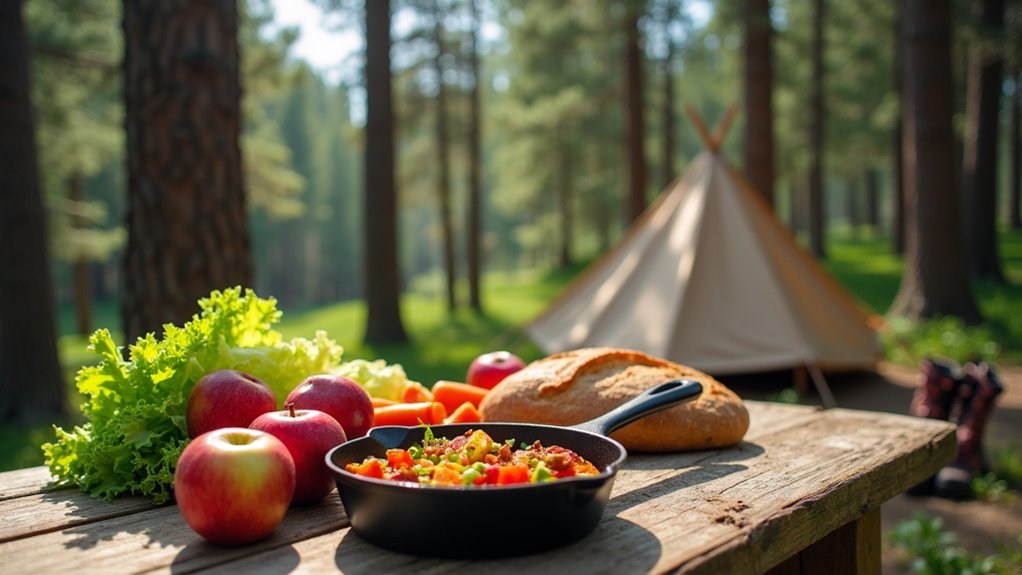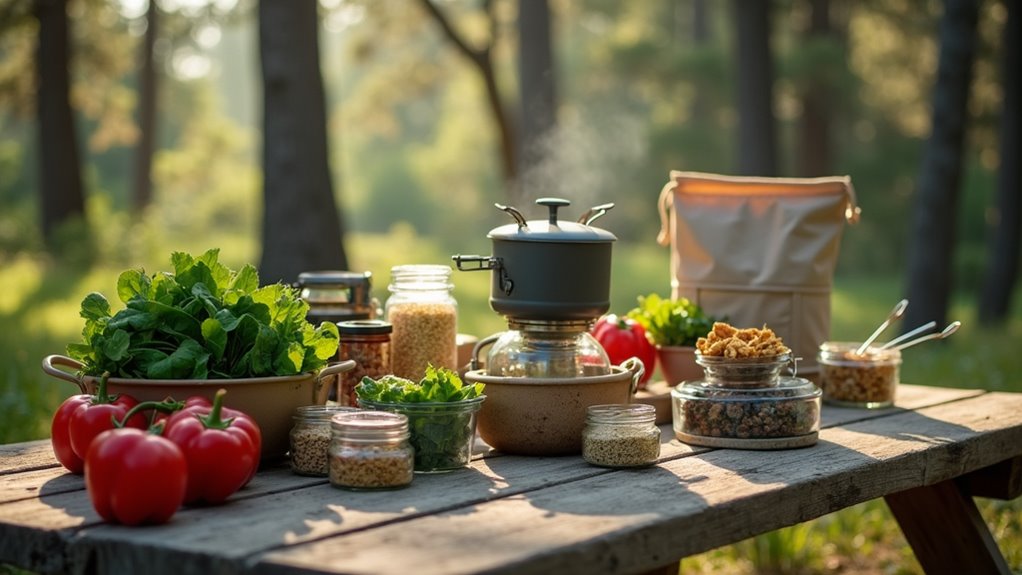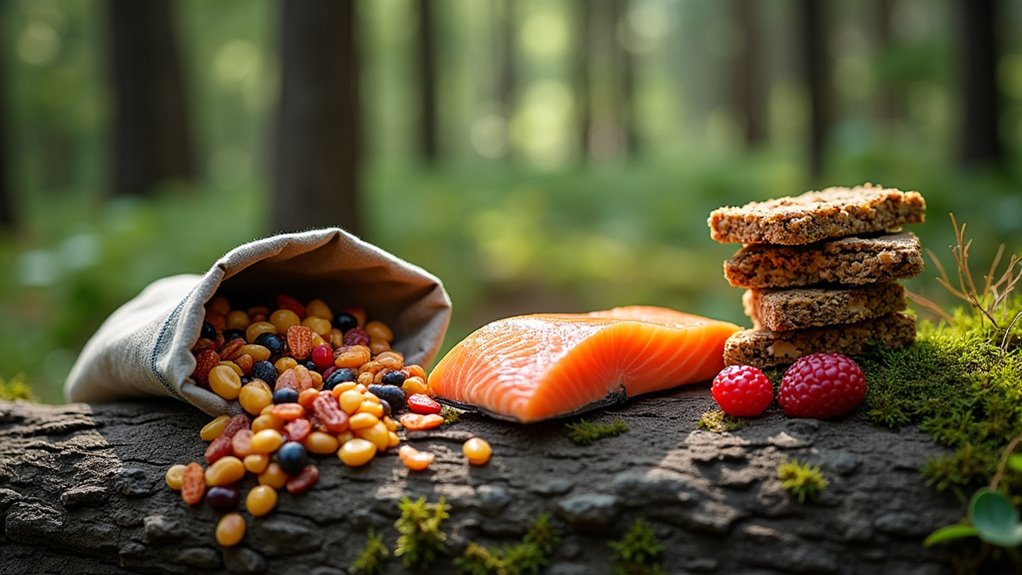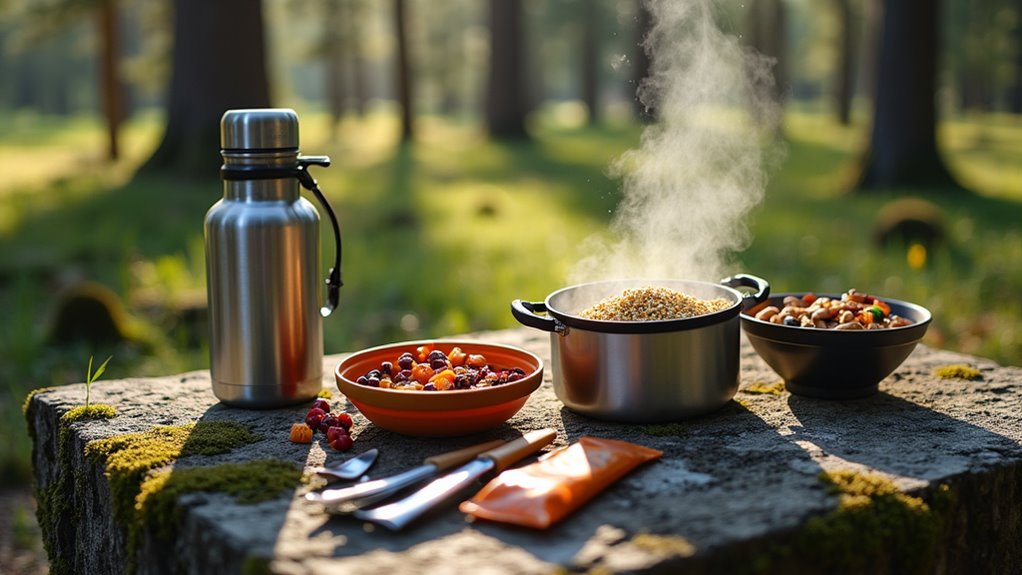Physical Address
304 North Cardinal St.
Dorchester Center, MA 02124
Physical Address
304 North Cardinal St.
Dorchester Center, MA 02124

Just discovered the game-changing secrets to eating nutritious wilderness meals that actually taste amazing and won't sabotage your outdoor adventure.
Did you know that campers consume 40% more processed foods than they do at home? You’re probably thinking that eating healthy in the wilderness means sacrificing taste or convenience, but that’s not true. With smart planning and the right approach, you’ll discover how to fuel your body with nutritious meals that won’t break the bank or weigh down your pack. The secret lies in understanding which foods work best in outdoor conditions and why your usual meal prep strategies won’t cut it.

Before you pack your backpack and lace up your hiking boots, you’ll want to map out your meals just as carefully as you’d plan your route. Start by calculating how many calories you’ll burn daily—typically 2,500-4,500 depending on your activity level.
Focus on lightweight, nutrient-dense foods that won’t spoil quickly.
Create a simple meal grid for each day, balancing proteins, carbs, and healthy fats. Dried beans, nuts, and jerky provide protein without refrigeration. Instant oatmeal, quinoa, and whole grain pasta deliver sustained energy.
Don’t forget fruits and vegetables—dried options work well and cost less than freeze-dried alternatives.
Make a detailed shopping list organized by food groups. This prevents impulse purchases and guarantees you won’t forget essential nutrients while you’re conquering trails.
Don’t overlook planning for your morning coffee ritual, as starting each day with a familiar and energizing beverage can boost morale during challenging outdoor adventures.
Having your meal plan locked down means nothing if you can’t actually cook those nutritious foods properly in the wilderness. You’ll need a reliable portable stove that won’t break your budget – a basic single-burner model works fine for most camping trips.
A basic single-burner portable stove is all you need to transform your wilderness meal plan into reality.
Pack a lightweight pot with a lid for boiling water and cooking grains, plus a non-stick pan for sautéing vegetables and proteins. Don’t forget a sharp knife, cutting board, and can opener.
A collapsible cooler keeps perishables fresh longer, while insulated food containers maintain temperatures. Bring aluminum foil for wrapping foods and creating cooking packets.
Finally, pack biodegradable soap and a scrub brush for cleanup. When selecting your cooking equipment, prioritize low impact camping gear that minimizes your environmental footprint in the wilderness. These basics cover most healthy cooking needs without weighing you down.

When you’re miles from the nearest grocery store, choosing the right non-perishable foods can make or break your camping nutrition goals. Focus on nutrient-dense options that won’t weigh down your pack or wallet.
Canned fish like salmon and sardines deliver protein and omega-3s without refrigeration. Dried beans, lentils, and quinoa provide complete proteins when combined. Nuts and seeds offer healthy fats plus essential minerals – almonds, walnuts, and pumpkin seeds are camping champions.
Don’t overlook fortified foods. Whole grain cereals and instant oatmeal pack B-vitamins and fiber. Dried fruits give you concentrated vitamins, while peanut butter adds protein and calories.
Stock up on shelf-stable milk, canned tomatoes for lycopene, and olive oil for cooking. These staples ensure you’re getting real nutrition, not just empty calories around the campfire. Remember that proper food storage is crucial to prevent contamination and foodborne illness when camping outdoors.
Although you’ve packed the perfect nutritious foods, they won’t do you any good if bears raid your campsite or bacteria spoils your meals. Store all food in bear-proof containers or hang it at least 12 feet high and 4 feet from tree trunks.
Keep perishables in a quality cooler with plenty of ice, checking temperatures regularly.
A reliable cooler packed with ample ice and consistent temperature monitoring keeps your perishable foods safe throughout your outdoor adventure.
Separate raw meats from other foods using sealed containers or double-bagged storage. Cook foods to proper temperatures—160°F for ground meat, 165°F for poultry.
Don’t leave cooked food out longer than two hours, or one hour in hot weather.
Pack a simple thermometer and use the “when in doubt, throw it out” rule. Your health isn’t worth risking food poisoning miles from medical help.
If you’re planning water-based camping adventures, consider whether renting or buying watercraft fits your budget and frequency of use for accessing remote fishing spots with fresh catch opportunities.

Mastering a few basic cooking techniques will transform your camping meals from bland survival food into satisfying dishes that fuel your adventures.
Start with one-pot meals using your portable stove – they’re efficient and minimize cleanup. Heat oil first, then sauté onions and garlic before adding proteins and vegetables.
For campfire cooking, build a proper coal bed rather than cooking over flames. Use cast iron skillets or Dutch ovens for even heat distribution.
Wrap vegetables in foil with seasonings for simple sides. Don’t forget the power of spice packets – they’re lightweight and add flavor without breaking your budget.
Pre-cut ingredients at home to save time and fuel. Keep cooking simple but flavorful.
Since dehydration can sneak up on you faster in the wilderness than at home, you’ll need to prioritize water intake and know where to find safe sources. Pack a reliable water filter or purification tablets—they’re cheaper than bottled water long-term. Look for flowing streams over stagnant ponds, and always treat water before drinking.
You’ll need about a gallon per person daily for drinking and cooking. Bring a lightweight, collapsible water container to maximize carrying capacity without bulk. If you’re car camping, frozen water bottles double as cooler ice that melts into drinking water.
Monitor your urine color—pale yellow means you’re hydrated. Don’t wait until you’re thirsty to drink, especially during physical activities like hiking. A quality camping water filter is essential equipment that can mean the difference between a successful outdoor adventure and a potentially dangerous situation.

Once you’ve got your hydration sorted, the real challenge becomes feeding yourself well without breaking your back—or your budget—carrying heavy ingredients. Smart planning means choosing foods that pull double duty: oatmeal packets mixed with nuts and dried fruit, pasta that cooks quickly and pairs with lightweight canned proteins, or tortillas that wrap around anything.
Focus on calorie-dense options like peanut butter, cheese, and trail mix. Skip fresh vegetables after day two—they’ll spoil and weigh you down. Instead, pack dehydrated veggies or instant soup mixes for vitamins.
Pre-portion meals at home to avoid overpacking. Energy bars work for breakfast, but don’t rely on them exclusively. Your body needs real fuel for those long hiking days. Mastering mountain camping cooking requires understanding how altitude and weather conditions affect your cooking methods and meal preparation strategies.
Picture yourself as a trail-tested hiker who’s learned that your body’s like a campfire – it needs quality fuel to keep burning bright. Studies show campers who plan nutritious meals report 40% higher energy levels throughout their trips. You don’t need expensive gear or gourmet ingredients; just smart choices and simple preparation. When you’re three miles from the nearest road, you’ll thank yourself for packing those nutrient-dense foods that keep your adventure fire burning strong.